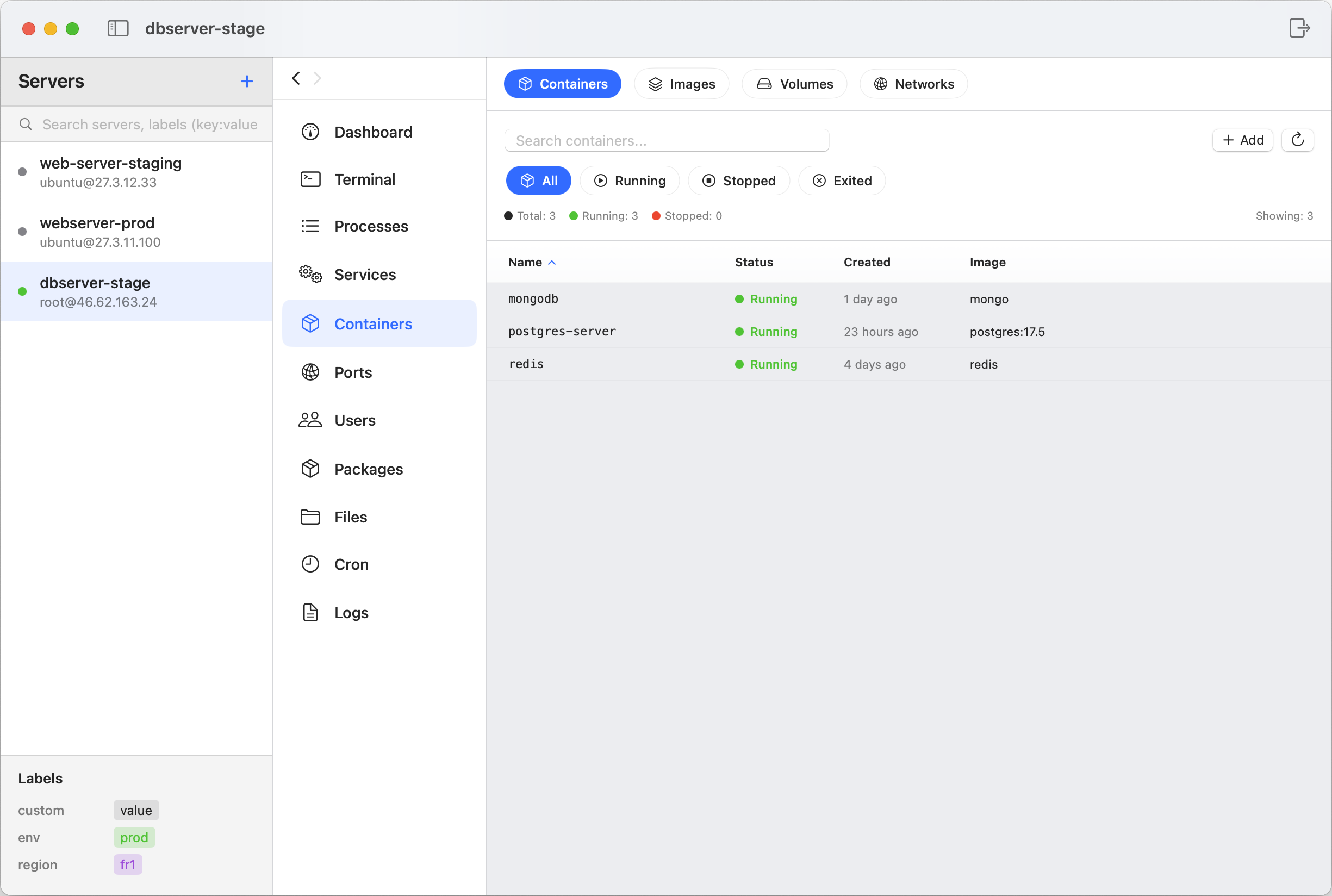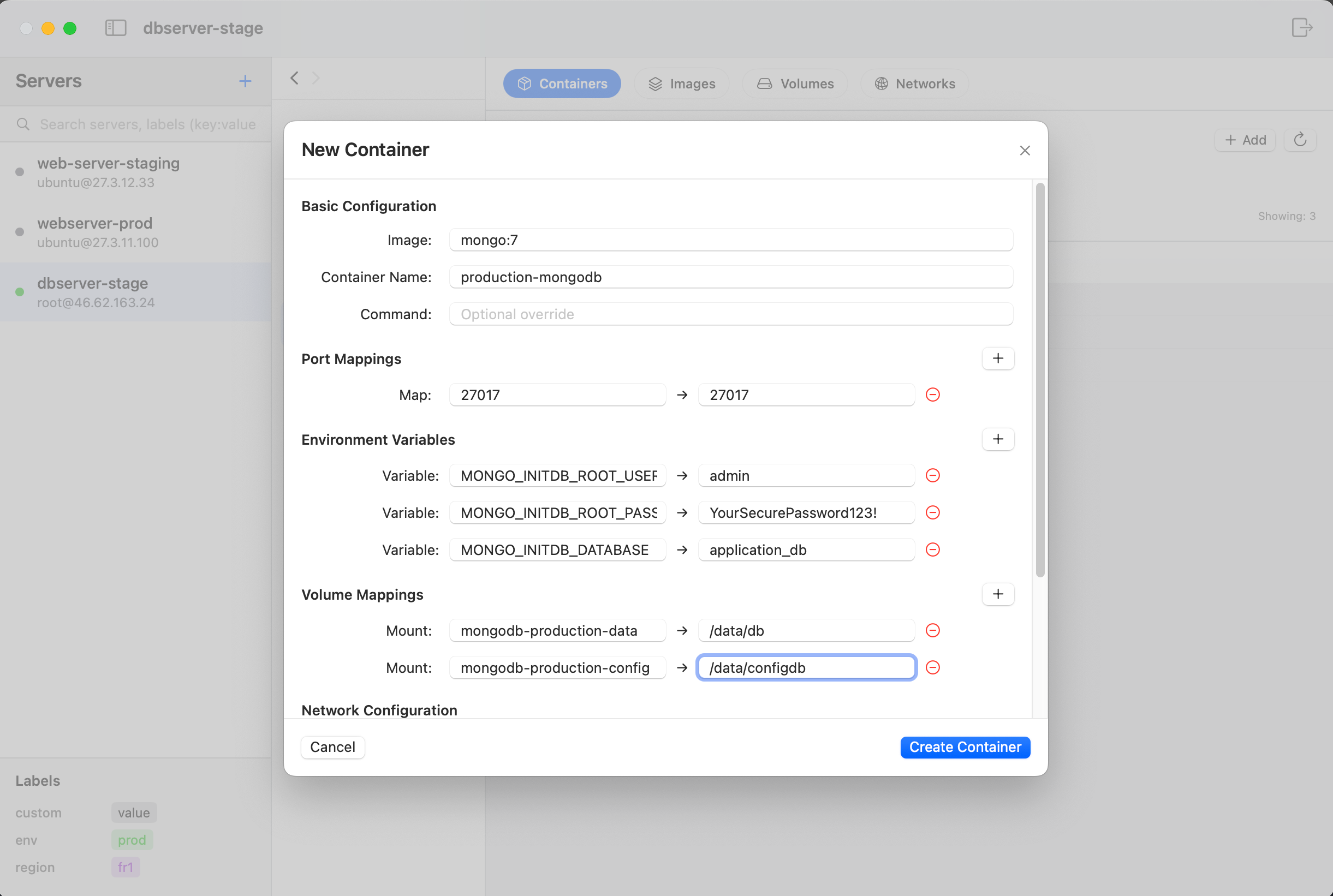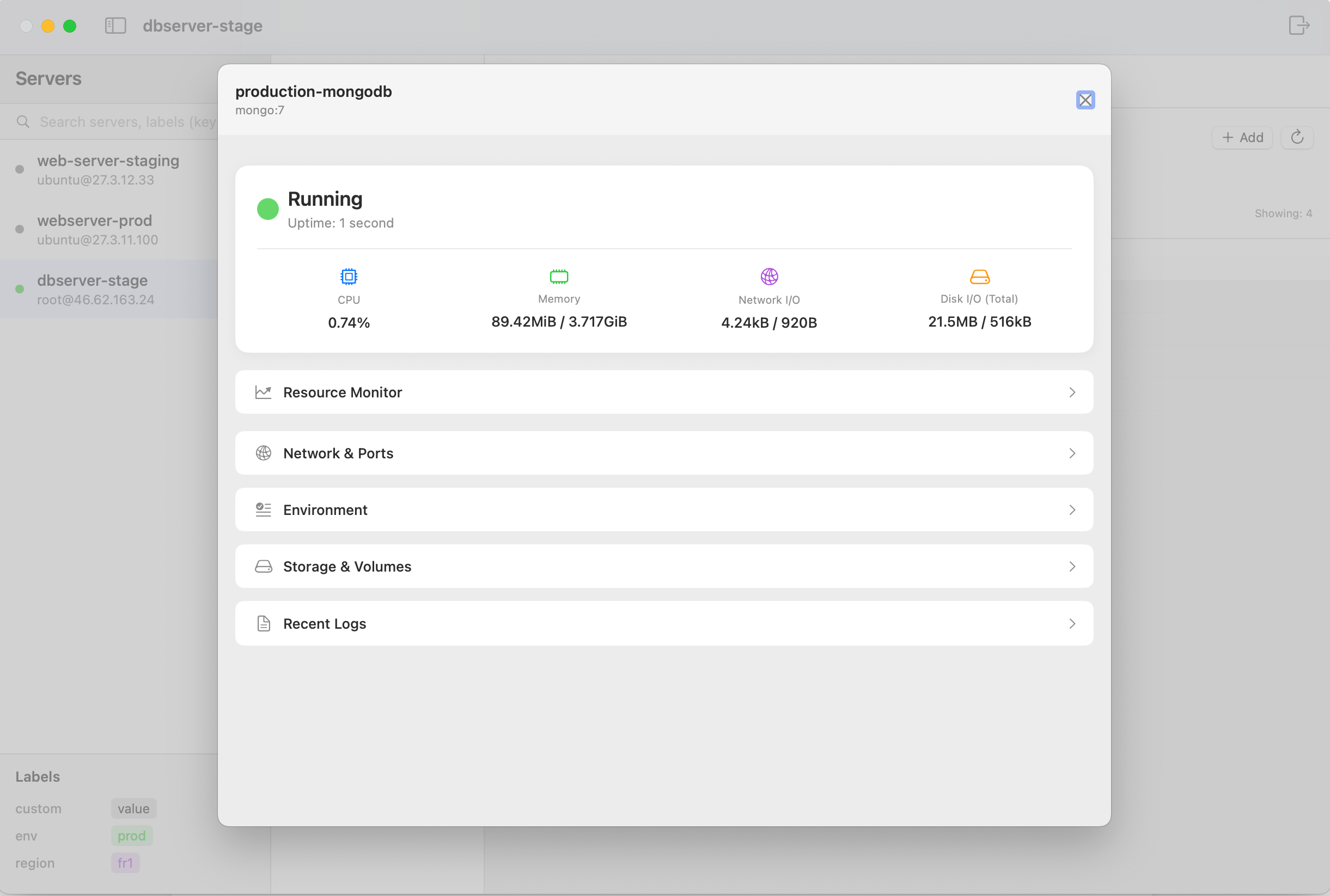How to Deploy and Monitor MongoDB Docker Containers
This guide walks through deploying MongoDB containers using ServerBuddy's visual interface, covering both basic deployments and production configurations.
Prerequisites
Your Linux server needs:
- Docker or Podman installed
- 512MB+ available RAM
- 10GB+ free disk space
You can check Docker installation by navigating to the "Containers" tab or by running the following in the Terminal:
docker --version
# or
podman --version
Creating a MongoDB Container with GUI
Step 1: Navigate to Docker Management
- Connect to your server via ServerBuddy
- Click the "Containers" tab

Step 2: Configure Container Parameters
Click the "+ Add" button in the top right to open the container dialog:
Basic Configuration
- Image:
mongo:7.0(ormongo:latestfor newest version) - Container Name:
production-mongodb(descriptive naming) - Command: Leave empty (uses MongoDB default entrypoint)
Port Mappings
Enter the following in the port mappings section:
- Host Port:
27017→ Container Port:27017 - Alternative: Use
27018on host if 27017 is occupied
Environment Variables (Critical for MongoDB)
Add these essential MongoDB environment variables:
| Variable | Value |
|---|---|
MONGO_INITDB_ROOT_USERNAME |
admin |
MONGO_INITDB_ROOT_PASSWORD |
YourSecurePassword123! |
MONGO_INITDB_DATABASE |
application_db |
Volume Mappings for Data Persistence
Configure persistent storage to survive container restarts:
- Mount:
mongodb-production-data(Docker volume name) - Container Path:
/data/db
Additionally, for configuration persistence:
- Mount: mongodb-production-config (Docker volume name)
- Container Path: /data/configdb
This ensures your database persists even if the container is removed.
Network Configuration
- Choose custom network for multi-container applications
- ServerBuddy shows available networks in a dropdown
Runtime Options
- Restart Policy: Select "Unless Stopped" for production
- ✅ Run in detached mode: Keeps container running in background
- ❌ Remove on exit: Keep unchecked for databases

Step 3: Deploy the Container
Click "Create Container" to:
- Pull the MongoDB image if not present
- Create volume directories
- Start the container with specified configuration
- Display creation status
The container should be running within 15-20 seconds.
Monitoring MongoDB Container Health
Container Status Indicators
The Docker containers view displays:
Container Status Indicators
- 🟢 Green: Running healthy
- 🟡 Yellow: Starting/restarting
- 🔴 Red: Stopped or errored
- ⚪ Gray: Paused
Available Container Actions
Hover over the container row to access:
- Start/Stop/Restart controls
Checking MongoDB Performance
Container Resource Usage
You can view this by double clicking on your container entry in the containers table.

The container details view shows:
- Memory consumption vs. limits
- CPU usage percentage (real-time graph)
- Network I/O rates (inbound/outbound)
- Disk read/write operations
MongoDB Internal Metrics
Connect via the Terminal tab:
- Click the Terminal tab
- Connect to MongoDB container
Connect to MongoDB:
docker exec -it production-mongodb mongosh -u admin -p
Run performance queries:
// Show database statistics
db.stats()
// Check current operations
db.currentOp()
// View server status
db.serverStatus()
// Check connection count
db.serverStatus().connections
// View collection statistics
db.collection.stats()
Log Analysis
You can view the logs for the container in the "Logs" tab by changing the log source to "Containers", and then selecting your container from the dropdown list.
The log viewer offers:
- Filtering by log level (ERROR, WARNING)
- Text search across logs
- Real-time updates
Troubleshooting Connection Issues
If you can't connect to MongoDB: 1. Check port mapping in container details (default: 27017) 2. Review container logs for authentication errors 3. Verify MongoDB authentication is configured correctly 4. Confirm firewall rules allow the connection 5. Check if bind IP is set correctly for external connections
Security Best Practices
- Always enable authentication with strong passwords
- Use MongoDB's built-in role-based access control
- Limit port exposure to specific IPs when possible
- Enable TLS/SSL for encrypted connections
- Set resource limits to prevent resource exhaustion
- Implement regular backup strategy
- Disable unnecessary MongoDB features
Common Issues and Solutions
Container Won't Start
- Check logs for error messages
- Verify port availability
- Ensure image exists
- Check volume mount permissions
- Verify sufficient disk space for MongoDB
Connection Refused
- Confirm container is running
- Verify port mapping
- Check firewall rules
- Review MongoDB authentication settings
- Ensure bind IP allows external connections
Authentication Failed
- Verify username and password
- Check if authentication is enabled
- Review user roles and permissions
- Ensure connection string includes authentication database
Key Takeaways
- Always use volumes for data persistence at
/data/dband/data/configdb - Set specific image tags (e.g., mongo:7.0) instead of 'latest'
- Enable authentication with MONGO_INITDB_ROOT_USERNAME and MONGO_INITDB_ROOT_PASSWORD
- Configure resource limits to prevent container from consuming all system resources
- Use restart policies for automatic recovery
- Monitor replica set health if running in cluster mode